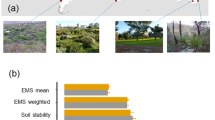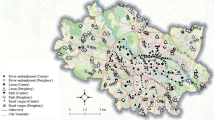Abstract
Aims
Urban ecosystems comprise a range of habitats that support key ecosystem processes that are fundamental for the functioning of their soils. Relatively little is known about how different types of urban greenspaces and settlement ages influence the functioning of these important environments.
Methods
We evaluated how four types of urban greenspaces (habitat types: natural areas, parks, gardens, roadside verges) and three settlement ages (5 to 150 years) influence multiple plant and soil ecosystem properties at 60 sites in two seasons in urban areas in eastern Australia.
Results
The type of urban greenspace and the age of the settlement influenced their ecosystem properties. In particular, habitat type had a greater effect on nutrient pools and plant biomass than settlement age, with greater nutrient pools in household gardens, but lower plant cover and plant height on roadside verges. Natural areas supported richer plant communities. We found that soil pH and soil moisture (particularly in summer) explained the contrasting effects of urban environments and settlement age on fundamental ecosystem properties. Older settlements tended to have lower soil pH, which was generally associated with greater enzyme concentrations. Soil pH effects varied depending on functions and season.
Conclusions
Our work highlights the importance of considering settlement age and urban greenspace type for understanding the complexity of urban ecosystems, and the functions that they provide to humanity. Understanding the links between urban habitats, settlement age and ecological functions is a first step to promoting practices that sustain healthy and productive urban environments.




Similar content being viewed by others
Data availability
Data will be uploaded to FigShare if the manuscript is accepted for publication.
References
Bardgett RD, Wardle DA, Yeates GW (1998) Linking above-ground and below-ground interactions: how plant responses to foliar herbivory influence soil organisms. Soil Biol Biochem 30:1867–1978
Bell CW, Fricks BE, Rocca JD, Steinweg JM, McMahon SK, Wallenstein MD (2013) High-throughput fluorometric measurement of potential soil extracellular enzyme activities. J Vis Exp 81:50–961
Benson DH (1992) The natural vegetation of the Penrith 1:100 000 map sheet. Cunninghamia 2:541–596
Berg G, Smalla K (2009) Plant species and soil type cooperatively shape the structure and function of microbial communities in the rhizosphere. FEMS Microbiol Ecol 68:1–13
Bezemer TM, Lawson CS, Hedlund K, Edwards AR, Brook AJ, Igual JM et al (2006) Plant species and functional group effects on abiotic and microbial soil properties and plant-soil feedback responses in two grasslands. J Ecol 94:893–904
Biasioli M, Barberis R, Ajmonemarsan F (2006) The influence of a large city on some soil properties and metals content. Sci Total Environ 356:154–164
Binkley D, Valentine D, Wells C, Valentine U (1989) An empirical analysis of the factors contributing to 20-year decrease in soil pH in an old-field plantation of loblolly pine. Biogeochemistry 8:39–54
Bolund P, Hunhammar S (1999) Ecosystem services in urban area. Ecol Econ 29:293–301
Campbell CD, Chapman SJ, Cameron CM, Davidson MS, Potts JM (2003) A rapid microtiter plate method to measure carbon dioxide evolved from carbon substrate amendments so as to determine the physiological profiles of soil microbial communities by using whole soil. Appl Environ Microbiol 69:3593–3599
Chadwick OA, Derry LA, Vitousek PM, Huebert BJ, Hedlin LO (1999) Changing sources of nutrients during four million years of ecosystem development. Nature 397:491–497
Colwell JD (1963) The optimization of the phosphorus fertiliser requirements of wheat in southern New South Wales by soil analysis. Aust J Exp Agric Anim Hus 3:190–197
Davies GM, Gray A (2015) Don’t let spurious accusations of pseudoreplication limit our ability to learn from natural experiments (and other messy kinds of ecological monitoring). Ecol Evol 5:5295–5304
Delgado-Baquerizo M, Maestre FT, Eldridge DJ, Singh BK (2016) Microsite differentiation drives the abundance of soil ammonia oxidizing bacteria along aridity gradients. Front Microbiol 7:505
Delgado-Baquerizo M, Bissett A, Eldridge DJ, Maestre FT, He JZ, Wang JT, Hamonts K, Liu YR, Singh BK, Fierer N (2017) Palaeoclimate explains a unique proportion of the global variation in soil bacterial communities. Nat Ecol Evol 1:1339–1347
Dunnett N, Quasim M (2000) Perceived benefits to human well-being of urban gardens. Hort Tech 10:40–45
Edmondson JL, Davies ZG, Gaston KJ, Leake JR (2014) Urban cultivation in allotments maintains soil qualities adversely affected by conventional agriculture. J Appl Ecol 51:880–889
Evans SE, Wallenstein MD (2011) Soil microbial community response to drying and rewetting stress: Does historical precipitation regime matter? Biogeochememistry 109:101–116
Fierer N, Bradford MA, Jackson RB (2007) Toward an ecological classification of soil bacteria. Ecology 88:1354–1364
Gaertner M, Brendon MH, Larson UM, Irlich PM, Holmes L, Stafford BW et al (2016) Managing invasive species in cities: A framework from Cape Town, South Africa. Landsc Urban Plan 151:1–9
Goddard MA, Dougill AJ, Benton TG (2009) Scaling up from gardens: biodiversity conservation in urban environments. Trends Ecol Evol 25:90–98
Goddard MA, Dougill AJ, Benton TG (2010) Scaling up from gardens: biodiversity conservation in urban environments. Trends Ecol Evol 25:90–98
Horgan BP, Branham BE, Mulvaney RL (2002) Mass balance of N-15 applied to Kentucky bluegrass including direct measurement of denitrification. Crop Sci 42:1595–1601
Hui N, Jumpponen A, Francini G, Kotze DJ, Liu X, Romantschuk M et al (2017) Soil microbial communities are shaped by vegetation type and park age in cities under cold climate. Environ Microbiol 19:1281–1295
Imperato M, Adamo P, Naimo D, Arienzo M, Stanzione D, Violante P (2003) Spatial distribution of heavy metals in urban soils of Naples city (Italy). Environ Pollut 124:247–256
Jenny H (1941) Factors of soil formation: a system of quantitative pedology. Dover Publications, New York
Keith DA (2007) Ocean shores to desert dunes. Department of Environment and Conservation, Sydney
Laliberte E, Zemunik G, Turner BL (2014) Environmental filtering explains variation in plant diversity along resource gradients. Science 365:1602–1605
Lorenz K, Lal R (2009) Biogeochemical C and N cycles in urban soils. Environ Int 35:1–8
Madrid L, Dıaz-Barrientos E, Madrid F (2002) Distribution of heavy metal contents of urban soils in parks of Seville. Chemosphere 49:1301–1308
Maestre FT, Delgado-Baquerizo M, Jeffries TC, Eldridge DJ, Ochoa V, Gozalo B et al (2015) Increasing aridity reduces soil microbial diversity and abundance in global drylands. Proc Natl Acad Sci USA 112:15684–15689
Newman ME, Girvan M (2004) Finding and evaluating community structure in networks. Phys Rev E 69:026113
Olsen SR, Sommers LE (1982) Phosphorus. In: Page AL (ed) Methods of Soil Analysis Part 2 Chemical and microbiological properties. American Society of Agronomy, Soil Science Society of America, Madison, pp 403–430
Osanai Y, Bougoure DS, Hayden HL, Hovenden MJ (2013) Co-occurring grass species differ in their associated microbial community composition in a temperate native grassland. Plant Soil 368:419–431
Padullés Cubino J, Cavender-Bares J, Hobbie SE, Pataki DE, Avolio ML, Darling LE, Neill C (2019) Drivers of plant species richness and phylogenetic composition in urban yards at the continental scale. Landsc Ecol 34:63–77
Pickett STA, Cadenasso ML (2009) Altered resources, disturbance, and heterogeneity: a framework for comparing urban and nonurban soils. Urban Ecosyst 12:23–44
Pouyat R, Groffman P, Yesilonis I, Hernandez L (2002) Soil carbon pools and fluxes in urban ecosystems. Environ Pollut 116:S107–S118
Ramirez KS, Leff JW, Barberán A, Bates ST, Betley J, Crowther TW et al (2014) Biogeographic patterns in below-ground diversity in New York City’s Central Park are similar to those observed globally. Proc R Soc B 281. https://doi.org/10.1098/rspb.2014.1988
Sinsabaugh RL, Lauber CL, Weintraub MN, Ahmed B, Allison SD, Crenshaw C et al (2008) Stoichiometry of soil enzyme activity at global scale. Ecol Lett 11:1252–1264
Spencer H, Scott N, Port G, Davison A (1988) Effects of roadside conditions on plants and insects. I. atmospheric conditions. J Appl Ecol 25:699–707
Stevens PR, Walker TW (1970) The chronosequence concept and soil formation. Q Rev Biol 45:333–350
Tresch S, Moretti M, Bayon L, Mäder R-C, Zanetta P, Frey A, D., et al (2018) A gardener’s influence on urban soil quality. Front Environ Sci 6. https://doi.org/10.3389/fenvs.2018.00025
UN (2007) World urbanization prospects: the 2007 revision. United Nations, New York
UN (2018) The World’s Cities in 2018: Data Booklet. The United Nations Department of Economic and Social Affairs, Population Division (ST/ESA/SER.A/417), New York
Wardle D, Bardgett RD, Klironomus J, Wall DH (2004) Ecological linkages between aboveground and belowground biota. Science 304:1629–1633
Zemunik G, Turner BL, Lambers H, Laliberté E (2015) Diversity of plant nutrient-acquisition strategies increases during long-term ecosystem development. Nat Plants 1:15050
Acknowledgements
We thank the Cities of Penrith and Richmond, and the many householders, for allowing us to collect soil and measure plants in their parks, roadsides and gardens. M.D-B. is also supported by a Ramón y Cajal grant from the Spanish Ministry of Science and Innovation (RYC2018-025483-I). M.D-B. was also supported by a 2019 Leonardo Grant for Researchers and Cultural Creators, BBVA Foundation (URBANFUN), and by a Large Research Grant from the British Ecological Society (Grant Agreement No. LRA17\1193, MUSGONET). Plant-microbial interaction work in BKS lab is supported by by the Australian Research Council project DP170104634. The BBVA Foundation accepts no responsibility for the opinions, statements and contents included in the project and/or the results thereof, which are entirely the responsibility of the authors.
Author information
Authors and Affiliations
Contributions
M.D-B. and M.B. conceived the study and M.B collected the data. B.K.S. undertook microbial analyses, D.J.E. analysed the data and wrote the first draft and all authors contributed critically to the drafts and gave final approval for publication.
Corresponding author
Ethics declarations
Conflict of interest
The authors declare no conflict of interest.
Additional information
Responsible Editor: Jeffrey Walck.
Publisher’s note
Springer Nature remains neutral with regard to jurisdictional claims in published maps and institutional affiliations.
Supplementary Information
ESM 1
(DOCX 1.08 MB)
Rights and permissions
About this article
Cite this article
Eldridge, D.J., Benham, M., Singh, B.K. et al. Ecosystem properties in urban areas vary with habitat type and settlement age. Plant Soil 461, 489–500 (2021). https://doi.org/10.1007/s11104-021-04836-w
Received:
Revised:
Accepted:
Published:
Issue Date:
DOI: https://doi.org/10.1007/s11104-021-04836-w




